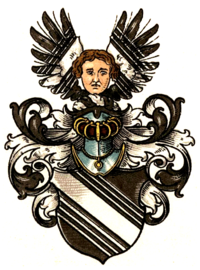Heygen (noble family)
Heygen (also Heyen or Heggen ) is the name of a Westphalian noble family ( knighthood ). Its headquarters are in the municipality of Heggen , today a district of Finnentrop in the Olpe district .
history
tribe
Hermann von Heygen is the oldest known representative of the family. In 1244 he had a dispute with the Oelinghausen monastery .
Herbord von Heygen (* approx. 1250, † 1340) was possibly his son or grandson. He belonged to the knight class ( miles ). 1313-1338 he was named as Vogt von Heggen and was enfeoffed by Count Wilhelm von Arnsberg with goods in Heggen and meal rights to Ahausen . In 1338 fishing rights were added. In 1325 he appeared as a witness for the Grafschaft monastery and in 1326 for the knight Theodor von Schnellenberg . After his death, his brother Hermann von Heygen, called Kulinch , was given the same rights by Count Gottfried von Arnsberg.
Franco von Heygen , (* approx. 1300, † 1365) a son or nephew of Herbord, succeeded the brothers and was listed in the Arnsberg fiefdom in 1342. In 1347 he sold their forest in Tecklinghausen to the pastor zu Helden . With his wife Katharina, geb. von Wenne , he had four children, Heidenreich, Johann, Franco and Hermann, through which different lines were established:
Heygen to Bamenohl
According to the latest findings, Bamenohl was first mentioned in a document on March 5, 1324.
Herbord Vogt von Heyen left Count Wilhelm von Arnsberg his own (Conradum) Konrad, the son of Dietrich von Adorpe, and in exchange received the tapestry from Nieder-Bamenohl ( Bawenole inferiore ).
This Herbordus von Heggen (Heyen) was a person who appears in several documents at the time in question and, as the Heggen village chronicle says, lived at that time. One of the Herbord's brothers was Franco. He had his son Heidenreich, who was married to Beleke von Hundem called Pepersack in his second marriage. Through this marriage, he and the von Heygen family came into the possession or partial ownership of Bamenohl. The von Heggen feudal lords were the Counts of Arnsberg. The aforementioned Wilhelm von Arnsberg was born around 1277, died in 1338, ruled as Count von Arnsberg from 1313 to 1338. So far nothing has been documented about the self-heard Konrad. Nothing is known about Dietrich (Theoderici) von Adorpe either, but it can be assumed that Adorpe is the district of Adorf in the Diemelsee municipality in the Waldeck-Frankenberg district. Siegler was Franckonis (Franco) von Snellenberg (Schnellenberg)
Heygen for ever
Johann von Heygen (* approx. 1340), the second son of Franco the Elder, married into the manor Ewig near Attendorn. 1412–1429, apparently after his death, the Augustinian Canons' Monastery Ewig was built there with the help of a foundation from the Attendorn merchant Heinrich Weeke , for which the manor formed the economic basis.
Wedekind von Heygen zu Ewig (* approx. 1370), his son, was mentioned between 1422 and 1446. In 1425 he inherited the Heggen estate from his late uncle Franco the Younger. His wife was named Meene.
Heinrich von Heygen zu Ewig (* approx. 1460, † 1544), a descendant of Wedekind, was married to a Clara, with whom he had four children: Johann, Margarethe, Elisabeth and Anna. Margarethe married Christoph von Schnellenberg zu Ahausen in 1544 , and her sisters entered the Oelinghausen monastery .
Johann von Heygen zu Ewig (* approx. 1490, † 1571) married Anna Wrede, heiress of Haus Amecke . The couple apparently ran into financial difficulties. In 1544 they sold their Mollberg estate to their brother-in-law Christoph von Schnellenberg and left him the tithe of Heggen. In 1566 they also pledged their farm to the husband of Christoph von Schnellenberg's daughter, Hermann von Neuhoff . After her death, the last property was divided among the four children on March 7, 1571: Johann von Heygen and his sister's husband, Johann von Bödinkhausen, received the estate in Ewig, Heinrich and Kaspar received the Amecke estate.
The family died out with the death of Engelbert Heinrich von Heygen, who was still alive in 1650.
coat of arms
The coat of arms shows in black a silver bar diagonally to the right, accompanied on both sides by three adjacent narrow silver bars. On the helmet with black and silver covers over a black and silver bead a natural human head between an open black flight covered with bars descending outwards.
More name bearers
- Lambertus Johannes van Heygen (1920–2007) Dutch Archbishop of Bertoua in Cameroon.
- Heinz Günter Heygen (* 1953) TV presenter
- van Heygen , Belgian shipping company in Ghent
Individual evidence
- ^ Westphalian document book, XI. Bd., 1301 - 1325 (2056), copy of the 14th century, StAM, Msc. VI 109 A (copy of Count von Arnsberg), sheet 33; Hist. A of the city of Cologne, Farragines Gelenii Bd. VII Bl. 63v-75. as well as a deposit in Lehnen in the Olpe district archive.
- ^ Max von Spießen : Book of Arms of the Westphalian Nobility, Görlitz 1901–1903, Volume 1, p. 68
literature
- Albert K. Hömberg : Historical news about noble houses and manors in the Duchy of Westphalia and their owners , Book IX.
- Max von Spießen : Book of Arms of the Westphalian Nobility , Görlitz 1901–1903, Volume 1, p. 68 - digitized
